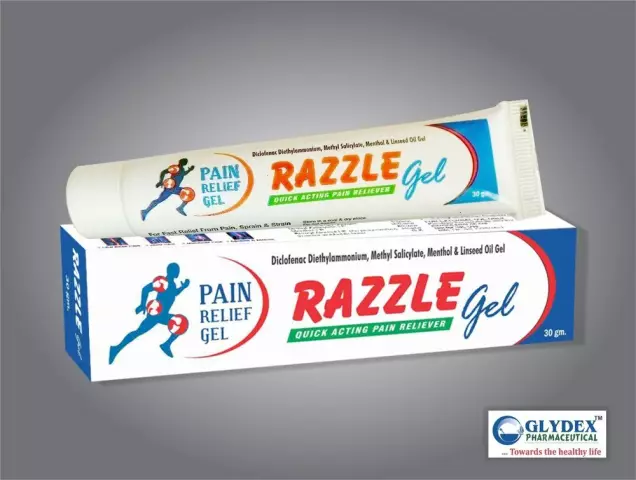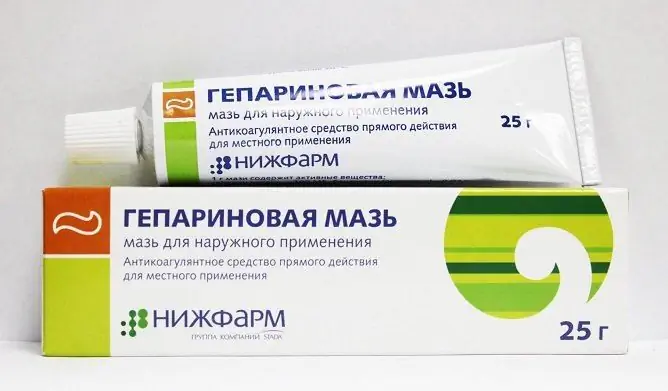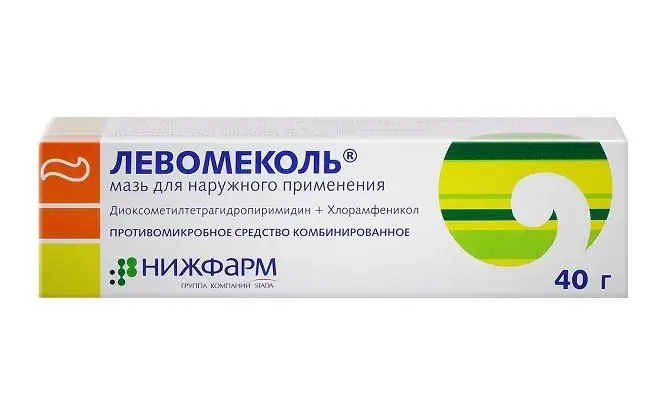- Author Rachel Wainwright [email protected].
- Public 2023-12-15 07:39.
- Last modified 2025-11-02 20:14.
Diclofenac
Instructions for use:
- 1. Release form and composition
- 2. Indications for use
- 3. Contraindications
- 4. Method of application and dosage
- 5. Side effects
- 6. Special instructions
- 7. Drug interactions
- 8. Analogs
- 9. Terms and conditions of storage
- 10. Terms of dispensing from pharmacies
Prices in online pharmacies:
from 13 rubles.
Buy

Diclofenac is a drug with analgesic, antipyretic and anti-inflammatory effects.
Release form and composition
Diclofenac is available in the following dosage forms:
- Enteric-coated tablets: orange or orange-yellow, round, biconvex (in blisters of 10 pcs., 1, 2, 3, 5, 10 packs in a cardboard box; in blisters of 20 pcs., 1-3 packages in a cardboard box; in dark glass jars, 30 pcs., 1 can in a cardboard box);
- Solution for intramuscular injection: transparent, from slightly yellow to colorless, with a characteristic faint smell of benzyl alcohol (in ampoules of 3 ml, 5 ampoules in blisters, 2 packages in a cardboard box);
- Ointment for external use: almost white or white, with a slight specific odor (in aluminum tubes of 30 g, 1 tube in a cardboard box);
- Gel for external use 1% or 5%: homogeneous, white with a cream or yellowish tint or white, with a specific odor (in aluminum tubes of 30 or 50 g, 1 tube in a cardboard box);
- Rectal suppositories: torpedo-shaped, white with a cream shade or white (in blisters, 5 suppositories, 2 packages in a cardboard box);
- Eye drops 0.1%: a transparent or almost transparent solution from light yellow to colorless (in polymer dropper bottles, 5 ml, 1 bottle in a cardboard box).
The composition of 1 enteric-coated tablet contains:
- Active ingredient: diclofenac sodium - 25 mg;
- Auxiliary components: milk sugar (lactose monohydrate), sucrose (granulated sugar), povidone (polyvinylpyrrolidone), potato starch, stearic acid.
The composition of the enteric coating: cellacephate, liquid paraffin, titanium dioxide, medical castor oil, tropeolin O dye.
The composition of 1 ml of solution for intramuscular administration includes:
- Active ingredient: diclofenac sodium - 25 mg;
- Auxiliary components: mannitol, propylene glycol, benzyl alcohol, sodium hydroxide, sodium sulfate, water for injection.
The composition of 1 g of ointment for external use includes:
- Active ingredient: diclofenac sodium - 10 mg;
- Auxiliary components: polyethylene oxide-400, polyethylene oxide-1500, dimexide, 1,2-propylene glycol.
The composition of 1 g of gel for external use includes:
- Active ingredient: diclofenac sodium - 10 or 50 mg;
- Auxiliary components: rectified ethanol, propylene glycol, carbomer (carbopol), methyl parahydroxybenzoate, trolamine (triethanolamine), lavender oil, purified water.
1 suppository contains:
- Active ingredient: diclofenac sodium - 100 mg;
- Auxiliary component: solid fat.
The composition of 1 ml of eye drops includes:
- Active ingredient: diclofenac sodium - 1 mg;
- Auxiliary components: hydrochloric acid (1M solution), macrogol glyceryl ricinoleate (polyethoxylated castor oil), disodium edetate dihydrate, trometamol, benzalkonium chloride, mannitol, purified water.
Indications for use
Diclofenac has no effect on the progression of the disease, it is intended for symptomatic therapy, to reduce inflammation and the severity of pain.
Diclofenac in the form of tablets and suppositories is prescribed for the following diseases / conditions:
- Pain syndrome in cancer, dental and head (including migraine) pain, sciatica, lumbago, radiculitis, ossalgia, myalgia, neuralgia, arthralgia, as well as postoperative and post-traumatic pain syndrome accompanied by inflammation;
- Diseases of the musculoskeletal system (degenerative and inflammatory), including ankylosing spondylitis (ankylosing spondylitis), psoriatic, rheumatoid, juvenile chronic arthritis, gouty arthritis, osteoarthritis, tendovaginitis, bursitis;
- Inflammatory processes in the small pelvis, including adnexitis;
- Algodismenorrhea;
- Infectious and inflammatory diseases of the ENT organs, accompanied by severe pain syndrome, including tonsillitis, pharyngitis and otitis media (as part of complex treatment).
Also, suppositories are used for febrile syndrome that occurs with flu and "colds" diseases.
The drug in the form of a solution for intramuscular administration is prescribed for the short-term treatment of pains of various origins of moderate intensity, including the following indications:
- Diseases of the musculoskeletal system (psoriatic, juvenile chronic arthritis, rheumatoid arthritis, ankylosing spondylitis, rheumatic lesions of soft tissues, gouty arthritis, osteoarthritis of the spine and peripheral joints, including those with radicular syndrome);
- Algodismenorrhea, inflammatory processes occurring in the pelvic organs, incl. adnexitis;
- Sciatica, lumbago, neuralgia;
- Postoperative pain;
- Post-traumatic pain syndrome accompanied by inflammation.
Outwardly, Diclofenac in the form of an ointment or gel is used for the following diseases / conditions:
- Traumatic soft tissue injuries;
- Muscle pains of non-rheumatic and rheumatic origin;
- Diseases of the musculoskeletal system, including rheumatoid arthritis, ankylosing spondylitis, psoriatic arthritis, osteoarthritis of the spine and peripheral joints;
- Rheumatic lesions of soft tissues.
Diclofenac eye drops are prescribed for the treatment of the following diseases / conditions:
- Inflammatory processes of non-infectious origin (including corneal erosion, conjunctivitis, keratoconjunctivitis, post-traumatic inflammation of the cornea and conjunctiva);
- Inflammatory process that developed after surgery;
- Inhibition of miosis during cataract surgery;
- Cystic edema of the macular retina after surgical removal of cataracts (treatment and prevention);
- Photophobia after keratotomy.
Contraindications
Contraindications to the use of Diclofenac in the form of tablets and suppositories are:
- A combination (incomplete or complete) of bronchial asthma and recurrent polyposis of the paranasal sinuses and nose with intolerance to acetylsalicylic acid or other nonsteroidal anti-inflammatory drugs (including a history);
- Active gastrointestinal bleeding;
- Inflammatory bowel disease;
- Erosive and ulcerative lesions of the stomach and duodenum;
- Severe hepatic and renal failure (creatinine clearance less than 30 ml per minute);
- Progressive kidney disease;
- Active liver disease;
- Confirmed hyperkalemia;
- The period after coronary artery bypass grafting;
- Severe heart failure;
- The third trimester of pregnancy and lactation period (in the I-II trimesters of pregnancy, Diclofenac can be used in the lowest dosage and according to strict indications);
- Children's age: tablets - up to 6 years; suppositories of 50 mg - up to 14 years old, 100 mg - up to 18 years old;
- Hypersensitivity to the components of the drug, as well as to other non-steroidal anti-inflammatory drugs.
Additional contraindications are:
- Tablets: impaired absorption of glucose-galactose, hereditary lactose intolerance, lactase deficiency;
- Suppositories: proctitis.
Diclofenac in these dosage forms should be used with caution in elderly patients (including those receiving diuretics), debilitated patients and patients with low body weight, with gastric ulcer and duodenal ulcer, Crohn's disease, ulcerative colitis, a history of liver disease, hepatic porphyria, arterial hypertension, chronic heart failure, a significant decrease in the volume of circulating blood, bronchial asthma, ischemic heart disease, cerebrovascular diseases, dyslipidemia / hyperlipidemia, diabetes mellitus, peripheral arterial disease, smoking and alcoholism, chronic renal failure, the presence of Helicobacter pylori infection, severe … Also, caution requires the simultaneous administration of Diclofenac with glucocorticosteroids (including prednisone),anticoagulants (including with warfarin), antiplatelet agents (including with acetylsalicylic acid, clopidogrel), selective serotonin reuptake inhibitors (including with citalopram, fluoxetine, paroxetine, sertraline) and with prolonged use of nonsteroidal anti-inflammatory drugs.
Contraindications to the use of Diclofenac in the form of a solution for intramuscular administration are:
- Erosive and ulcerative lesions of the gastrointestinal tract (in the acute phase);
- Hematopoietic disorders;
- "Aspirin" asthma;
- Pregnancy and lactation;
- Age up to 15 years;
- Hypersensitivity to the components of the solution (including to other non-steroidal anti-inflammatory drugs).
Diclofenac (solution) should be used with caution in elderly patients, as well as in induced acute hepatic porphyrias, heart failure, severe renal and hepatic impairment.
Topical use of Diclofenac is contraindicated in the following diseases / conditions:
- "Aspirin" asthma;
- Violation of the integrity of the skin;
- Third trimester of pregnancy and lactation;
- Age up to 6 years;
- Hypersensitivity to the components of the drug, as well as to acetylsalicylic acid or other non-steroidal anti-inflammatory drugs.
Diclofenac in the form of ointment and gel should be used with caution in elderly patients, pregnant women in the I-II trimesters, as well as with exacerbation of hepatic porphyria, erosive and ulcerative lesions of the gastrointestinal tract, severe functional disorders of the kidneys and liver, chronic heart failure, bronchial asthma, bleeding disorders (including hemophilia, prolonged bleeding time, tendency to bleed).
Eye drops are contraindicated for hypersensitivity to drug components. Diclofenac drops should be used with caution in elderly patients and children, pregnant women in the I-II trimesters, as well as with bronchial asthma caused by the intake of acetylsalicylic acid, epithelial herpetic keratitis (including in history), diseases associated with coagulation disorders blood, including hemophilia, bleeding tendency and lengthening of bleeding time.
Method of administration and dosage
Diclofenac in the form of tablets should be taken orally without chewing and drinking enough water, preferably 30 minutes before a meal (to achieve a quick therapeutic effect). It is also possible to take the drug before, during or after meals.
For children over 15 years old and for adults, Diclofenac is prescribed 2-3 times a day for 25-50 mg (maximum 150 mg per day). After improvement, the dose is gradually reduced and switched to maintenance therapy - 50 mg per day.
When treating juvenile rheumatoid arthritis, the daily dose can be increased to 3 mg / kg body weight.
For children, the drug is usually prescribed in the following doses (single / daily):
- 6-7 years (20-24 kg) - 25/25 mg;
- 8-11 years old (25-37 kg) - 25 / 50-75 mg;
- 12-14 years old (38-50 kg) - 25-50 / 75-100 mg.
Diclofenac in the form of a solution should be administered deeply intramuscularly. A single dose for adults is 75 mg. If necessary, no earlier than 12 hours later, the drug may be re-administered. Therapy should be carried out no longer than 2 days, after which you need to switch to taking pills.
Suppositories are administered rectally. Adults are usually prescribed 100-150 mg per day, divided into 2-3 doses. With prolonged therapy and in mild cases, the drug is used at 100 mg per day. If suppositories are used simultaneously with taking the drug inside, the total dose of Diclofenac should not exceed 150 mg.
When the first symptoms of algodismenorrhea appear, suppositories are prescribed in an initial daily dose of 50-100 mg, which, if necessary, is increased to 150 mg during several menstrual cycles.
At the first signs of a migraine attack, Diclofenac is used at a dose of 100 mg. If necessary, repeated administration at the same dose is possible. If continued treatment is required, the daily dose should not exceed 150 mg (in several injections).
Children from 14 years old are usually prescribed 1 suppository of 50 mg up to 2 times a day.
Outwardly, children over 12 years of age and adults should apply the drug, rubbing slightly, onto the skin 3-4 times a day. The required amount of Diclofenac is determined by the size of the painful area. A single dose is 2-4 g. Children 6-12 years old should not use more than 2 g of the drug up to 2 times a day.
Diclofenac in the form of eye drops is instilled into the conjunctival sac before surgery, 1 drop 5 times within 3 hours, immediately after surgery - 3 times 1 drop, then 3-5 times a day for the time necessary for treatment.
For other indications, usually 1 drop is prescribed 4-5 times a day. The average duration of therapy is up to 28 days. Before a longer use of Diclofenac, a detailed ophthalmological examination and accurate diagnosis should be performed. As a rule, therapy is extended from one to several weeks.
Side effects
When using Diclofenac in tablet form, the following side effects may develop:
- Nervous system: often - dizziness, headache; rarely - sleep disturbances, depression, irritability, drowsiness, aseptic meningitis (more often in patients with systemic lupus erythematosus and other systemic connective tissue diseases), nightmares, convulsions, disorientation, general weakness, a feeling of fear;
- Gastrointestinal tract: often - nausea, diarrhea, constipation, abdominal pain or spasm, bloating, flatulence, peptic ulcer with possible complications, increased activity of "hepatic" transaminases, gastrointestinal bleeding without ulcers; rarely - damage to the esophagus, vomiting, melena, jaundice, blood in the feces, aphthous stomatitis, cholecystopancreatitis, hepatitis (possibly fulminant course), dryness of the mucous membranes (including the oral cavity), cirrhosis, liver necrosis, changes in appetite, hepatorenal syndrome, colitis, pancreatitis (including with concomitant hepatitis);
- Respiratory system: rarely - bronchospasm, cough, pneumonitis, laryngeal edema;
- Cardiovascular system: rarely - increased blood pressure; extrasystole, congestive heart failure, chest pain;
- Genitourinary system: often - fluid retention; rarely - oliguria, papillary necrosis, nephrotic syndrome, proteinuria, interstitial nephritis, hematuria, azotemia, acute renal failure;
- Skin: often - skin rash, itching; rarely - urticaria, alopecia, toxic dermatitis, eczema, punctate hemorrhages, toxic epidermal necrolysis (Lyell's syndrome), erythema multiforme exudative (including Stevens-Johnson syndrome), increased photosensitivity;
- Sense organs: often - tinnitus; rarely - scotoma, diplopia, blurred vision, impaired taste, irreversible or reversible hearing loss;
- Hematopoietic organs and the immune system: rarely - anemia (including aplastic and hemolytic anemia), thrombocytopenia, leukopenia, agranulocytosis, eosinophilia, thrombocytopenic purpura, worsening of infectious processes;
- Allergic reactions: rarely - anaphylactoid reactions, allergic vasculitis, swelling of the tongue and lips, anaphylactic shock (usually developing rapidly).
When using the drug in the form of a solution for injection and suppositories, similar side effects can be observed. A burning sensation may occur at the site of intramuscular injection, and it is also possible to develop aseptic necrosis, infiltration and necrosis of adipose tissue. When using suppositories, in rare cases, edema may occur.
When applied externally, side effects are rare. They usually manifest as itching, rash, redness and local burning.
When using eye drops, the following disorders may develop:
- Digestive system: vomiting, nausea;
- Allergic reactions: photosensitivity, flushing, itching in the eyes, angioedema of the face, chills, fever, skin rash, erythema multiforme;
- Local reactions: blurred vision (immediately after instillation), burning eyes, corneal opacity, iritis.
special instructions
With prolonged use of Diclofenac, it is necessary to monitor liver function, analysis of feces for occult blood and a picture of peripheral blood.
During the period of therapy, it is possible to reduce the speed of motor and mental reactions, in connection with which one should refrain from driving vehicles and performing other potentially hazardous types of work that require a high concentration of attention and quick psychomotor reactions.
Drug interactions
With the simultaneous use of Diclofenac with certain drugs, undesirable effects may occur (consultation with a doctor is necessary).
Analogs
Diclofenac's analogs are: Adolor, Bioran, Diclofenac-Altpharm, Diclofenac-Ratiopharm, Diclofenac-Akos, Diclofenac-Eskom, Diclofenac-Akrihin, Diclofenac-MFF, Diclofenac-Retinac-MFF, Diclofenac-Retiniclone-Phytalon, Diclofenac-Akos, Dorosan, Voltaren, Voltaren Emulgel, Voltaren Ofta, Ortofen, SwissJet, Naklofen SR, Uniclofen.
Terms and conditions of storage
Store in a dark, dry place out of reach of children at temperatures up to 25 ° C.
Shelf life:
- Enteric-coated tablets and eye drops - 3 years;
- Solution for intravenous administration, rectal suppositories, gel and ointment for external use - 2 years.
After opening the bottle, the eye drops can be used for 4 weeks.
Terms of dispensing from pharmacies
Forms for external use are dispensed without a prescription, tablets and solution - by prescription.
Diclofenac: prices in online pharmacies
|
Drug name Price Pharmacy |
|
Diclofenac 50 mg enteric-coated tablets 20 pcs. RUB 13 Buy |
|
Diclofenac (eye drops) 0.1% eye drops 5 ml 1 pc. RUB 15 Buy |
|
Diclofenac 50 mg enteric-coated tablets 20 pcs. RUB 20 Buy |
|
Diclofenac (ointment) 2% ointment for external use 30 g 1 pc. RUB 21 Buy |
|
Reviews Diclofenac (ointment) RUB 21 Buy |
|
Diclofenac (eye drops) 0.1% eye drops 5 ml 1 pc. 22 RUB Buy |
|
Diclofenac (suppositories) 50 mg rectal suppositories 10 pcs. RUB 23 Buy |
|
Reviews Diclofenac (candles) RUB 23 Buy |
|
Diclofenac 25 mg / ml solution for intramuscular administration 3 ml 5 pcs. RUB 27 Buy |
|
Diclofenac ointment 1% 30g 28 RUB Buy |
|
Diclofenac 50 mg rectal suppositories 10 pcs. 28 RUB Buy |
|
Diclofenac (ointment) 1% ointment for external use 30 g 1 pc. 28 RUB Buy |
|
Reviews Diclofenac (ointment) 28 RUB Buy |
|
Diclofenac (ointment) 1% ointment for external use 30 g 1 pc. RUB 29 Buy |
|
Diclofenac retard 100 mg enteric-coated tablets with prolonged action 20 pcs. RUB 29 Buy |
|
Diclofenac eye drops 0.1% fl. 5 ml RUB 31 Buy |
|
Diclofenac retard Obolenskoe 100 mg enteric-coated prolonged-release tablets 20 pcs. 32 RUB Buy |
|
Diclofenac 75 mg / 3 ml solution for intramuscular administration 3 ml 10 pcs. RUB 33 Buy |
|
Diclofenac 75 mg / 3 ml solution for intramuscular administration 3 ml 10 pcs. RUB 33 Buy |
|
Diclofenac (for injection) 25 mg / ml solution for intramuscular administration 3 ml 5 pcs. RUB 33 Buy |
|
Diclofenac (suppositories) 100 mg rectal suppositories 10 pcs. 34 rbl. Buy |
|
Diclofenac (for injection) 25 mg / ml solution for intramuscular administration 3 ml 10 pcs. 34 rbl. Buy |
|
Diclofenac (for injection) 25 mg / ml solution for intramuscular administration 3 ml 10 pcs. 35 RUB Buy |
|
Diclofenac 1% gel for external use 30 g 1 pc. RUB 36 Buy |
|
Diclofenac 1% gel for external use 30 g 1 pc. RUB 37 Buy |
|
Diclofenac (for injection) 25 mg / ml solution for intramuscular administration 3 ml 10 pcs. RUB 37 Buy |
|
Diclofenac Retard-Akrihin tablets p.p. with prolonged release. 100mg 20 pcs. RUB 38 Buy |
|
Diclofenac retard-Akrihin 100 mg film-coated tablets of prolonged action 20 pcs. RUB 38 Buy |
|
Diclofenac supp. rekt. 50mg No. 10 RUB 40 Buy |
|
Diclofenac retard obolinskoe tablets p.p. intestinal. 100mg 20 pcs. RUB 44 Buy |
| See all offers from pharmacies |
Information about the drug is generalized, provided for informational purposes only and does not replace the official instructions. Self-medication is hazardous to health!






